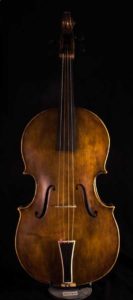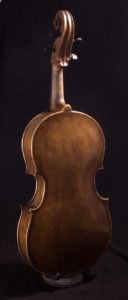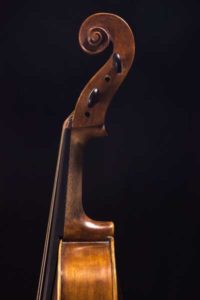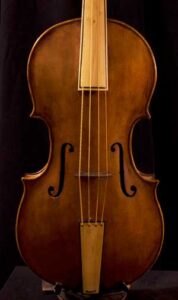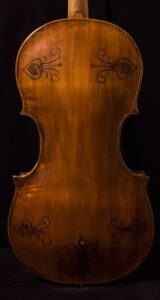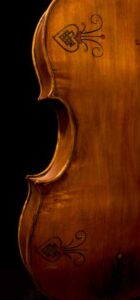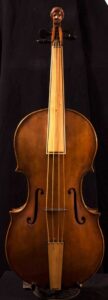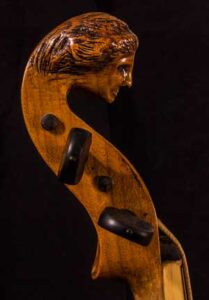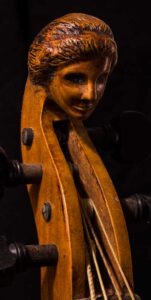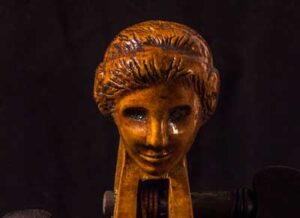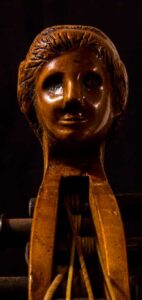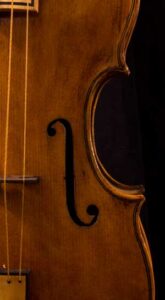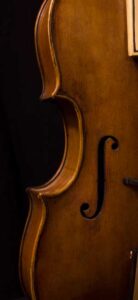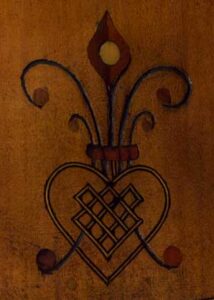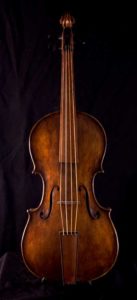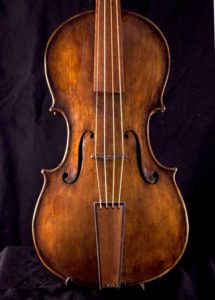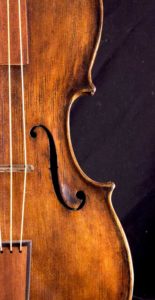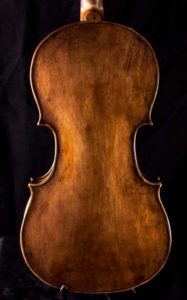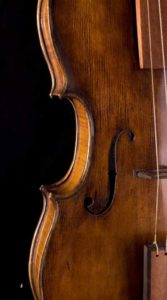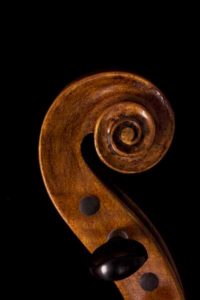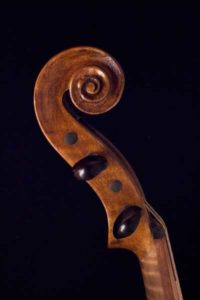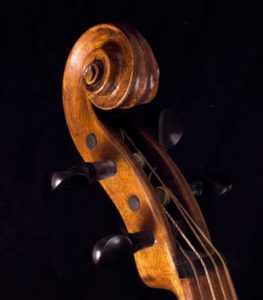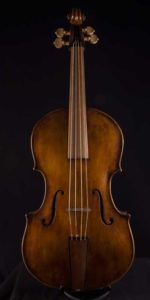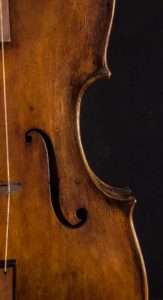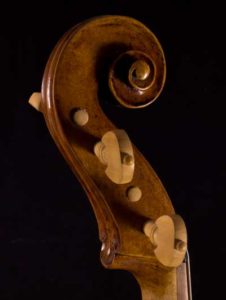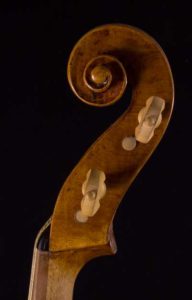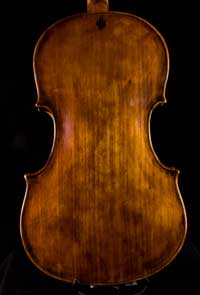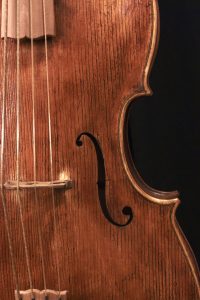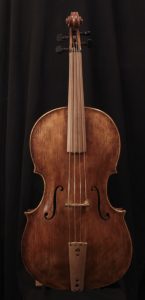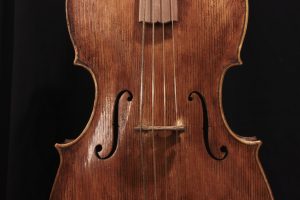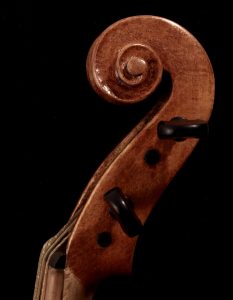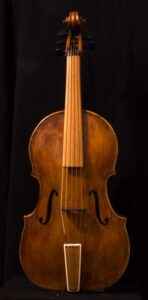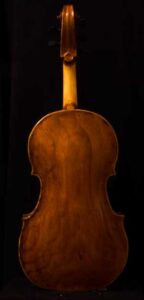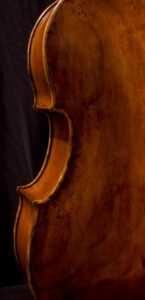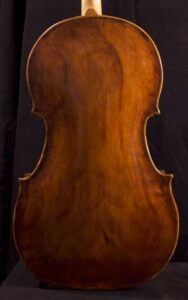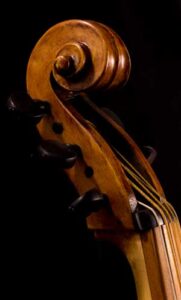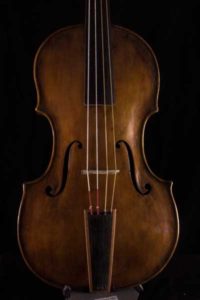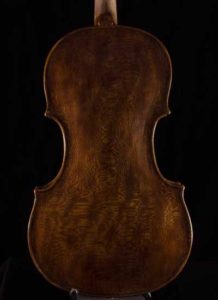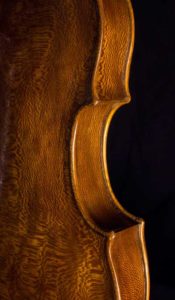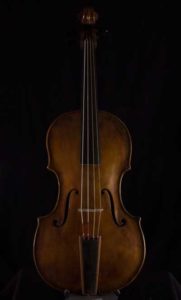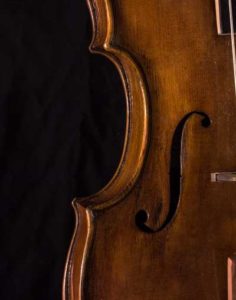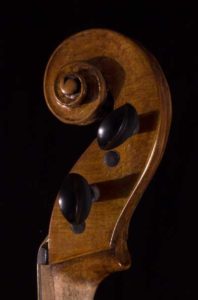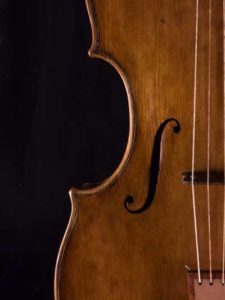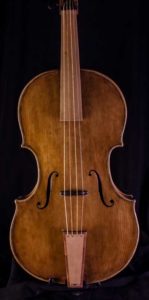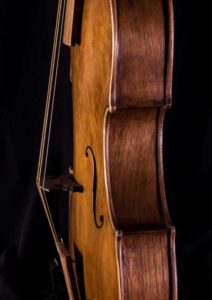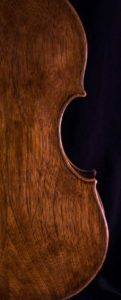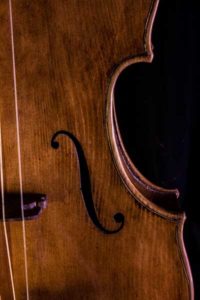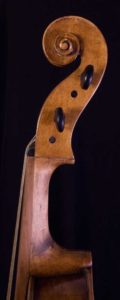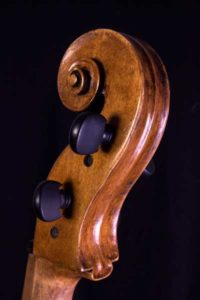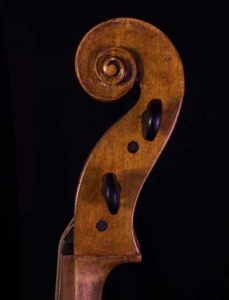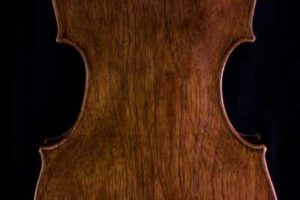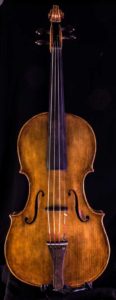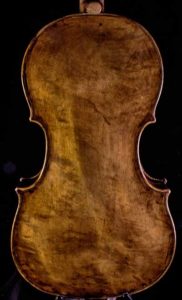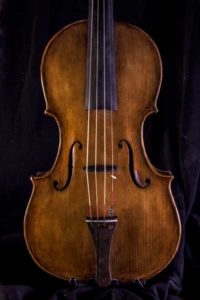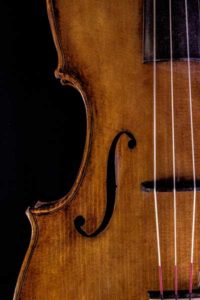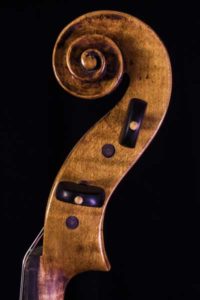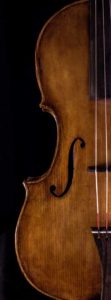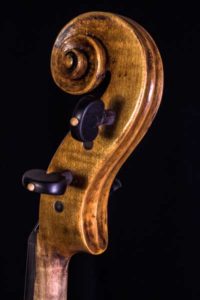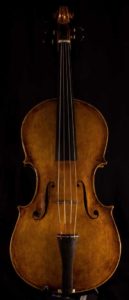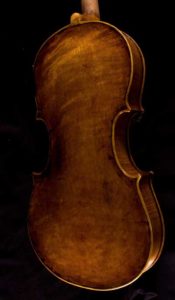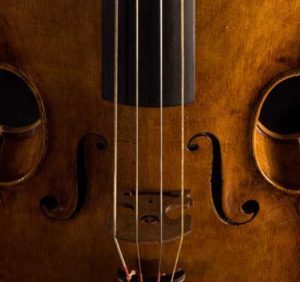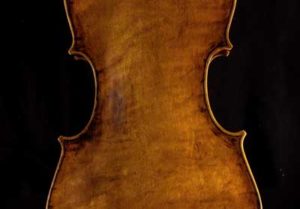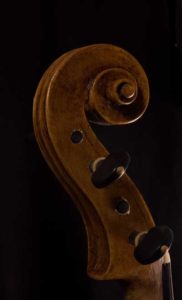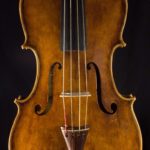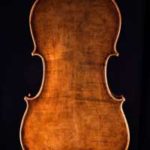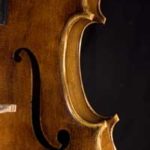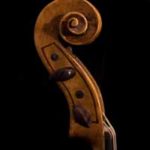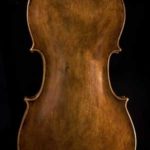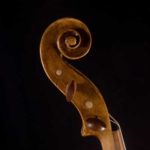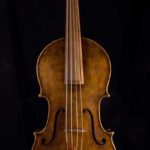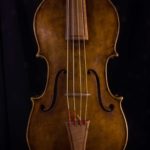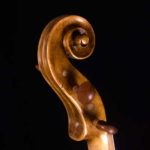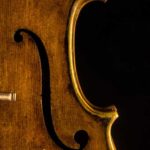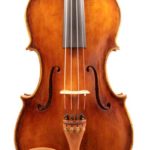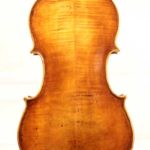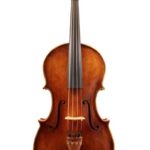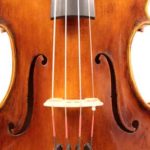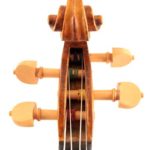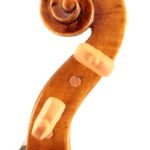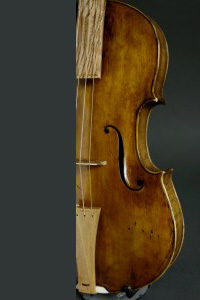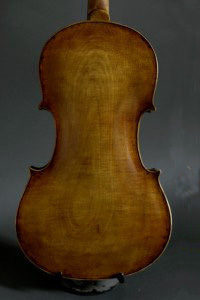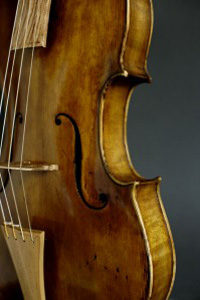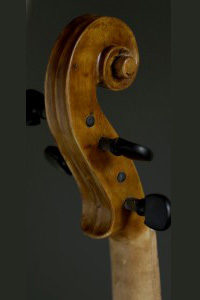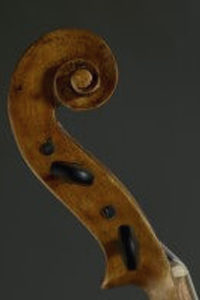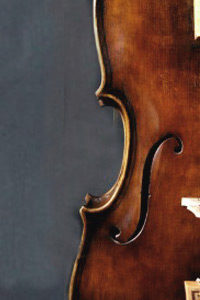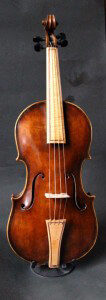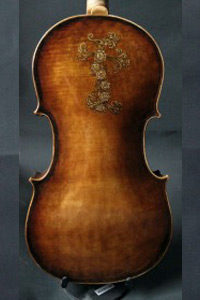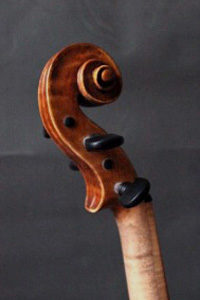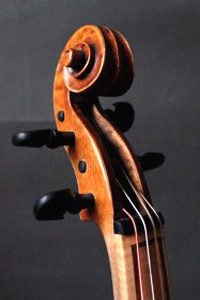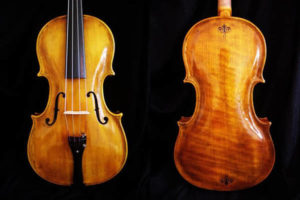![]() Below one may peruse images of finished violas for sale in Baroque and late Renaissance setup. I also include several modern-setup instruments in tenor and alto sizes. In a career spanning 30 years as luthier, the instrument has often been my specialty as a luthier. A short history of the baroque tenor viola can be read here.
Below one may peruse images of finished violas for sale in Baroque and late Renaissance setup. I also include several modern-setup instruments in tenor and alto sizes. In a career spanning 30 years as luthier, the instrument has often been my specialty as a luthier. A short history of the baroque tenor viola can be read here.
Baroque Tenor Viola after Johann Michael Alban.
I have long wished to make a copy of this truly grand tenor by Johann Michael Alban in the collection of the Kunsthistorische Museum in Wien. The original is a very rare example of larger tenors which have not been cut down in the 19th C. to make smaller instruments. One may note that the very deep ribs are so extreme as to push the boundary between large tenor viola and violoncello piccolo. This aspect of the instrument becomes more obvious when one examines the outline, which very much resembles an Amati cello form.
This is the finest viola yet made out of hundreds, and has been my personal instrument for several years. Available in New York City at 8KEuro. Please contact Dan McCarthy for more information.
Phantasie Viola inspired by Hans Krauchdaler
A pure flight of fantasy, this instrument lends a respectful nod towards the Black Forest school of violin making in the 17th Century. Although this tradition of Lutherie never actually adorned their scrolls with human heads or other sculpture, the temptation was too great to embark upon pure poetry when making this very special viola. Often lovingly adorned with complex intarsia, the Krauchtaler school produced some of the first contralto-sized violas ever to come to life. This viola will be available for trial in June, 2023 at the Boston Early Music Festival . (SOLD)
Viola after Carlo Bergonzi 16″ alto in Baroque Setup
Carlo Bergonzi (1683-1747) in his work managed to find a beautiful balance between some of the finer traits of Guarneri del Gesu, and Stradivari. The back is of Italian poplar with tonal qualities similar to the softer willow species. The voice is strong and yet sweet, with the projection one can expect from a cremonese model. Currently available for trials and sale at Brobst Violins. (SOLD)
Viola in Baroque setup after Gaspar Borbon 41cm
This highly arched viola has a willow back, making it a light and very playable instrument. The tone is silky and dark, with very lovely response. The C-string is brooding and powerful, with real clarity; something rare for smaller string lengths. Currently available for trial and sale at Bridgewood and Neizert in London. (SOLD)
50cm Tenor in All-Gut, Late Renaissance Setup.
Surprisingly comfortable played on the shoulder, this giant viola has a killer C-string, and also works wonderfully with a low tension tenor violin tuning. Currently being used for concerts worldwide by Dan McCarthy. For your pleasure you may listen to this instrument here.
Viola Pomposa, inspired by Johann Traugott Mosch/ J.C. Hoffmann/JohannWagner
A specially commissioned instrument for Oreste de Tommaso.
While the 19th and 20th Century Psyche generally relates the Viola Pomposa to the anomalous instruments of J.C. Hoffmann, thus conjuring the aenigma of their context within the compositions of Bach and the violoncello piccolo, the connection remains, and seemingly will remain, tenuous. Nevertheless, larger corpus violas with cello-like qualities survive today, miraculously, despite the 19th C. carnage of rib reduction, and the practice of cutting down to make more “playable” violas for profit.
From an Organological perspective, 5-string instruments made by Johann Mosch, Christian Gottlieb Klinger, as well as those by Hoffmann, all seem to display an unmistakable Verwandtschaft to the very common German and Italian tenors with 45-48cm LOB/ rib depths at 55-70mm, thus blurring the line between violoncello piccolo and tenor. This instrument (45.5 Korpus) will have a relatively short string length of 39cm, similar to the Johann Wagner instrument. The one-piece back of richly marbled willow will dampen the harshness of a traditional, maple back, and the use of Pearwood for the rib garland, have produced a rich and resonate, clear, bass/tenor sound.
Alto Viola 38.5cm Inspired by Deconet.
Smaller violas have a potential for crisp, clear alto voices and were quite common in 18th Century lutherie. Makers such as Michelle Deconet and Benjamin Banks most often produced instruments at 39cm or smaller. This viola has a rich and bright tonal range, with a surprising amount of power on the C string given the size. (SOLD)
Tenor Viola with Early Baroque/late Renaissance setup, 48cm Corpus.
This giant tenor viola with all-gut stringing is made entirely of cedar, with limewood scroll. I have used Cedrela Oderata (often known as Spanish Cedar ) for the back and ribs, Western Red Cedar for the top. Cedrela, as you may know, is not a true cedar species, more closely related to the Mahogany family. It was used by Michel Colichon for several 18th Century viola da gambas now famous for their fine tone. It is a remarkably resonant wood. Historically tenors this large usually had very short necks at 12cm (shorter than the modern violin neck!) making them manageable instruments. The viola is being used for concerts with Monteverdi String Band
Viola in Modern Setup after Giovanni Grancino
Giovanni Grancino (1637-1709) was one of the earliest makers to refine the school of instrument making in Milan, influencing many other generations to follow. His son, Giovanni Battista also produced very fine examples of this often unfairly criticized school of lutherie. In contrast to many Milanese instruments I have chosen fine materials for the back; the slab cut maple beautifully catches the light with a golden/amber varnish. This is the first modern setup viola I have made in several years. The back measures 41.5cm. (SOLD)
Viola in Late Baroque setup, Gagliano inspired.
Inspired by the lutherie of Naples, this highly-arched viola has a sweet but well-projecting voice with lots of character. The work first began in 2012 with the aim of making a viola with late baroque setup which would also be suited for classical repertoire. The instrument has aged in the white for over fours years in Vienna. (SOLD)
16″ Viola with Modern Setup after Giovanni Pistucci.
Giovanni Pistucci, born in Naples in1864, generally made “inspired” copies based upon Gagliano models. He was however as original as he was prolific; on nearly every instrument, (circa 800 violins, 200 violas, and 25 violoncelli) an unmistakable personal style shines forth and is fairly remarkable. One telling feature of his workmanship are the often pronounced and long protruding corners; a restless personal freedom in fashioning the corner blocks can be seen on all of his instruments. The rather longish sound holes seem to be further accentuated by eccentric middle bouts, and these terminating in corners and edge work which truly cn every single instrument. Scroll profiles vary wildly, almost as if carved freehand, with occasionally deeply sculpted fluting on the back of the pegbox, throats which are wide and open, or with other instruments, almost non existent. I personally love the instruments of Pistucci, if only because he seemed to be so restless in the search for a personal aesthetic. While some details of his work could be judged as crude, his instruments are known for their fine tone. Varnish colors vary as often and accordingly with the other restless attributes of his artistry.
For this viola I have sought as usual to capture several elements of multiple instruments by this master. Long corners are a matter of course, purfling distance set close to the edges, however with a tasteful amount of antiquing/wear. This instrument has low arching and was meant to be a viola intended for a soloist, with much projection and power to its tone. Wide sound holes, and a slightly higher inclination to the neck angle have resulted in more tension towards this aim.
The rib garland, scroll head, and back plate have been seasoned “in the white” for four years in Vienna, and nearly one year in Spain. (SOLD)
Baroque Viola 16″ Inspired by Carlo Giuseppe Testore.
One of the first baroque violas finished and made entirely in Spain, this baroque viola has a back of willow, top of spruce aged over ten years. The fittings are of pear wood and all handmade. Carlo Giuseppe (c. 1665–1738) was the patriarch of the Testore family, and although his double basses are much more common, a few violas do exist which are unique and beautiful. Milanese instruments are usually built without a mould, as is this particular viola. Musicians can expect a very comfortable and versatile instrument, with even, balanced tone. It is a myth that willow produces instruments with less projection and power; this viola has a wonderful range of tonal color and a lovely, antique sound which I am always seeking. (SOLD)
- bridge Milan viola in baroque setup
Viola with Modern/Classical setup 16″ Personal Model after G.B Rogeri.
Long fascinated by the various models of Giovanni Battista Rogeri, this is a personal model viola with lower arching, though as one can see, deeply sculpted and dramatic. G.B. Rogeri often did very elegant merging of Cremonese and Brescian traditions in his instruments. (SOLD)
Brescian Tenor Viola with Baroque Setup.
This Tenor Baroque viola of 17″ corpus is currently located in Florence, Italy. The beautiful slab-cut maple back is one of many I have aged in the workshop from a single tree source and used for several instruments. All have sounded wonderful. Currently available for trials in Italy at 6K Euro
Baroque Alto Viola after Giovanni Paolo Maggini, Vienna 2012.
A custom Baroque Viola for Peter Rose in England. Another beautiful slab cut maple back, and lovely ornamental painting on the back upper bout. This Brescian-inspired viola with a corpus of 16″ was simply one of the finest sounding smaller violas I have yet made. Peter performs with Leeds Baroque, and other ensembles in England.
16 inch Viola in modern setup inspired by Giulio (Julius Cesare) Gigli
Roman maker Giulio Gigli worked in the style of David Tecchler and was apprentice to Michael Platner in 1738. His work shows the influence of both Roman masters, however also is often arguably finer in the free-sprited intepretations of the Stainer/Amati arching and tone. This was one of my earlier instruments where I took many liberties in the deeply-scooped arching terminations, soundholes, and decorative carvings in the back. Gigli most often created rich, golden yellow varnishes; what can be seen below is my humble tribute to this maker. (SOLD)
HAVE QUESTIONS?
Feel free to use the form below to contact me and start a dialogue about your musical needs.

